TREES
(eight of them)
Today I went to Batelle Darby Metro Park, scouting out the place for tomorrow’s class field trip. There are trees there. Who knew? As Gabriel Popkin explained so well in her article (LINK), a lot of otherwise well-educated people are “tree blind.” I’m a botanist, so I guess I’m somewhat less tree blind than most folks, but still have a lot to learn, especially about oaks and hickories …and pines …and hawthorns, and…
American sycamore
(Platanus occidentalis)
American sycamore is also a lowland tree, occurring mainly along rivers, but it also does well as a street tree, perhaps because of similar stresses, namely low oxygen concentration in the soil around the root system.
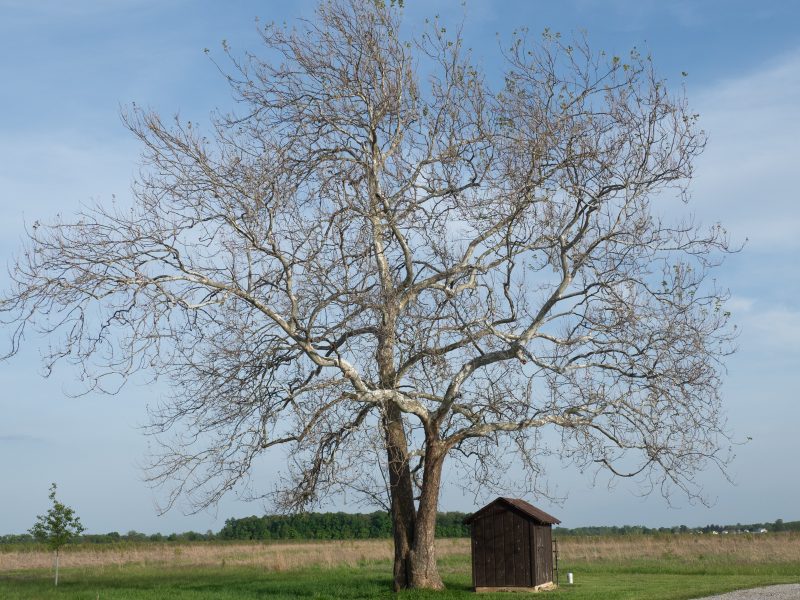
American sycamore
Platanus occidentalis
Sycamore can get very big! In “Flora of West Virginia,” P. D. Strausbaugh and Earl L.Core mention some pioneers named John and Samuel Pringle who lived in a hollow sycamore tree near the present site of Buckhannon (Upshur County WV) from 1764 to 1768. Sounds like fun, but it could get old after a while. (“I am so sick of this sycamore!”)
The leaves are alternate in arrangement, simple in complexity, and palmately lobed. (Were it not for the non-opposite leaf arrangement, one could mistake this for a maple.)
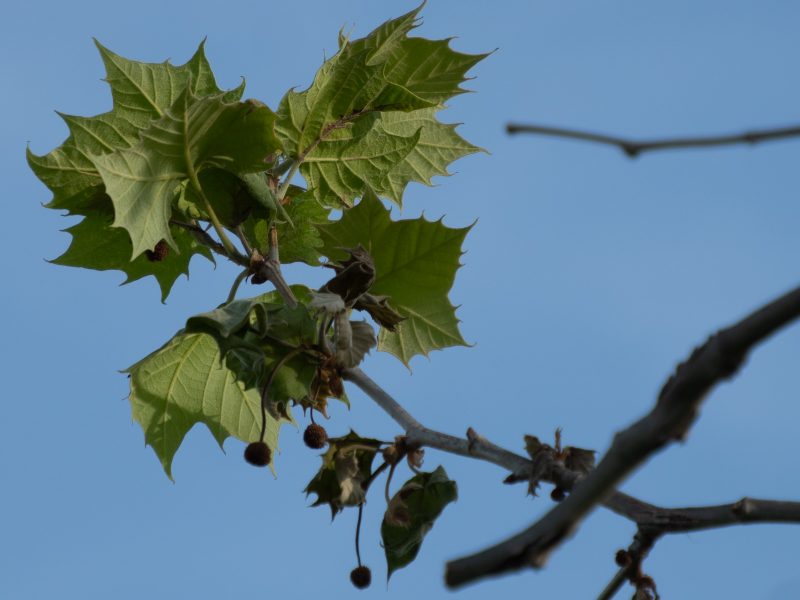
American sycamore leaves look rather maple-like.
American sycamore is sometimes called “buttonwood” A web site called “Dave’s Garden” (LINK) has an explanation, saying the name is self-explanatory as it was a favorite wood for making buttons. Dave also tells us that the New York Stock Exchange was founded in 1792 according to a pact made beneath a sycamore growing along Wall Street, henceforth called the “Buttonwood Agreement.”
Eastern Cottonwood
(Populus deltoides)
At the he restored wetland called “Watts Wetland,” eastern cottonwood thrives in the low-lying soil.
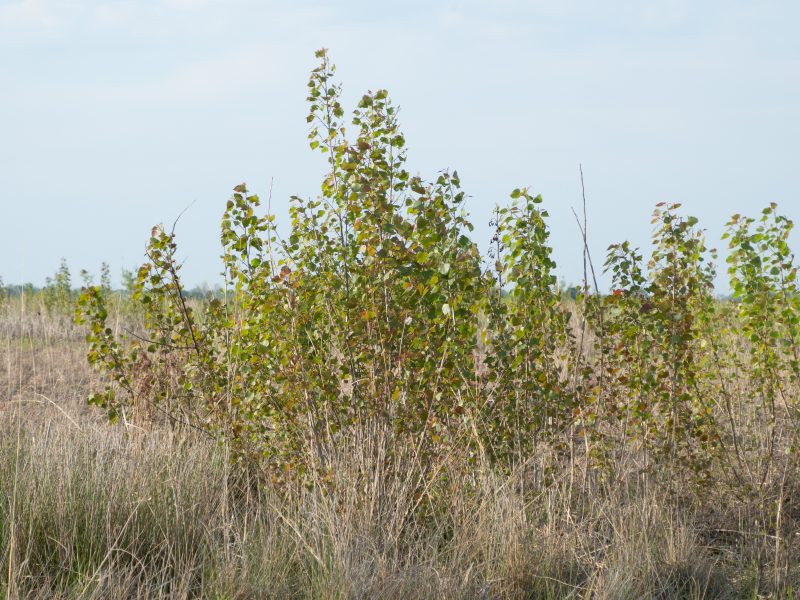
Young eastern cottonwood trees thriving in the wetland.
This is a fast-growing lowland species, in the same genus (Populus) as aspen. Here’s a tree joke: Question: Why do places like Indonesia, India and China have so many aspen and cottonwood trees? Answer: Because those are very Populus places!
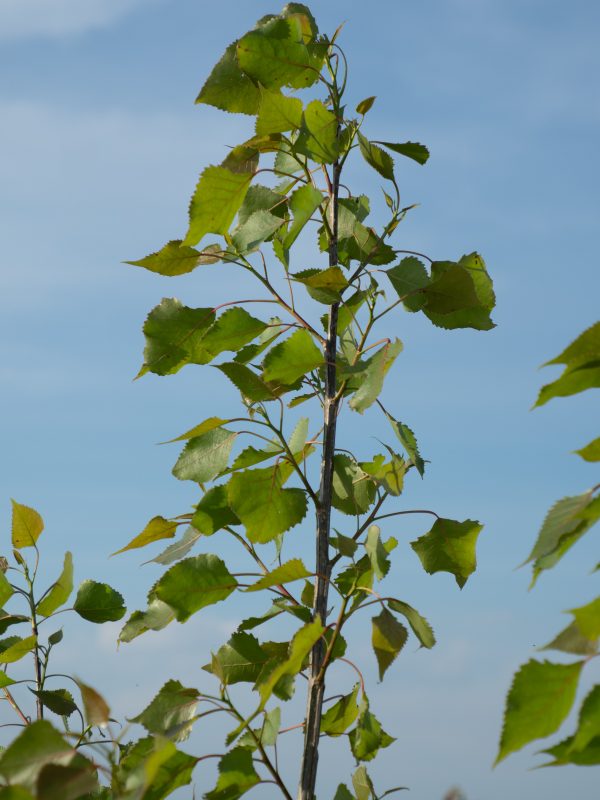
Eastern cottonwood has triangular leaves.
Eastern cottonwood leaves are distinctively triangular. The specific epithet “deltoides” in in reference to the leaf shape.
Aspen and cottonwood leaves tremble in the slightest breeze because they have flattened petioles. (I call them “linguine leafstalks.”)
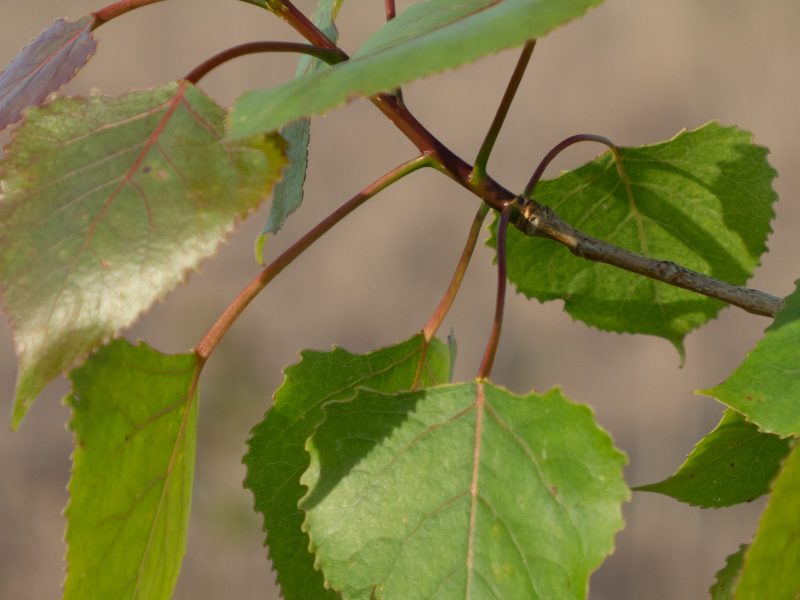
Linguine leafstalks!
Ohio Buckeye
(Aesculus glabra)
Ohio buckeye is a distinctive small tree, owing to its large, oppositely arranged palmately compound leaves. There are many of them growing at the Cedar Ridge Picnic Area portion of the park.
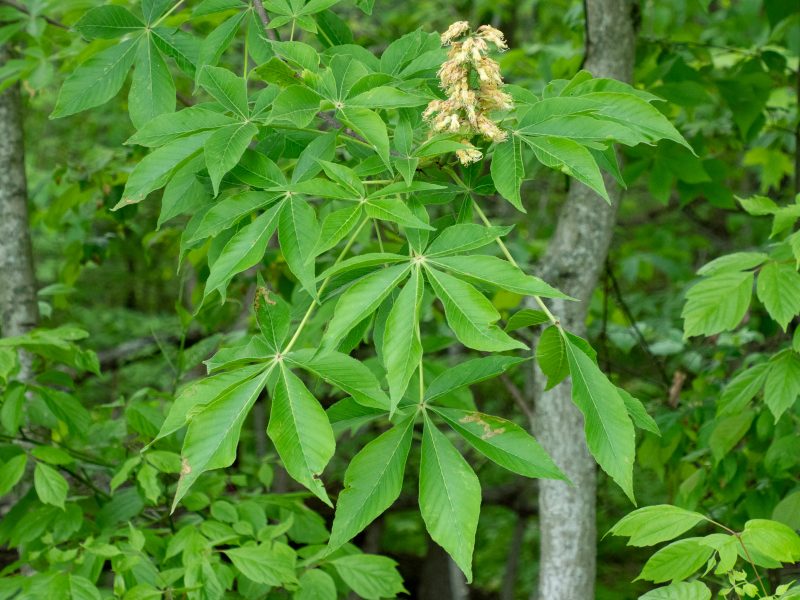
Buckeye has opposite palmately compound leaves.
As explained so well by Joe Boggs, writing for OSU Agricultural Extension HERE (link) an odd syndrome of drooping laves is caused by the presence of the larvae of a small native moth called the Buckeye Petiole Borer (Proteoteras aesculana). Eggs are laid on the leafstalk and a caterpillar bores into it, where it devours some of the contents, cutting off circulation to the leaf, which eventually dies and drops to the ground.
Red elm
(Ulmus rubra)
Elm (genus Ulmus) have leaves that are simple in complexity, with a doubly-serrate margin, and a peculiarly unequal-sided leaf base. There are two common species in Ohio –American elm (U. americana) and red/slippery elm, U. rubra. They are quite similar. Red elm leaves are more scratchy above than are those of American elm, and there are also some differences in the bark and the fruits.
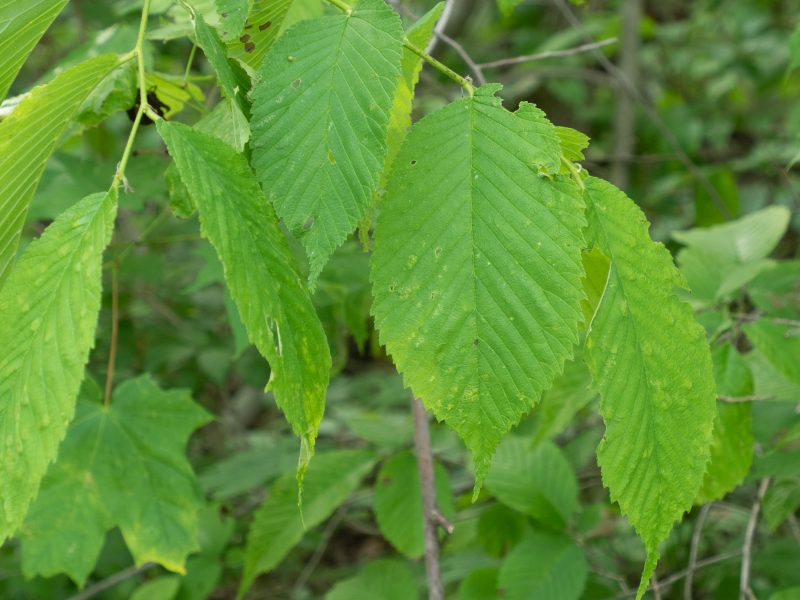
Elm leaves are doubly serrate –their teeth have teeth!
In North America, elm tree populations are a mere remnant of what they once were. As explained very well by the Morton Arboretum, the disease –which is probably of Asiatic, not Dutch, origin was accidentally introduced to the U.S. in the 1930’s. It is a fungus that is carried by two species of bark beetles. All of our native elms are susceptible. The fungus blocks the water-carrying xylem tissue, causing affected branches to wilt and die. Because elms reproduce at an early age, there are still elms around, just not many forest giants like there once were. In her “tree blindness” article, Popkin mentions several other introduced tree pathogens, citing primarily the emerald ash borer as a consequence of global trade, whicj is noted to be “only the latest iteration of this sad story; chestnuts, hemlocks and elms have already taken major hits from foreign pests.”
Whoa! While hunting for trees I spied a dead one –probably an ash –that had an ichneumon wasp, possible a “giant ichneumon wasp,” Megarhyssa atrata, which lays eggs in horntail larvae deep in the wood of dead trees.
Hackberry
(Celtis occidentalis)
Hackberry is a member of the elm family (Ulmaceae) and shares with elms the overall leaf appearance –simple, alternate, doubly-serrate, and with an unequal-sided leaf base.
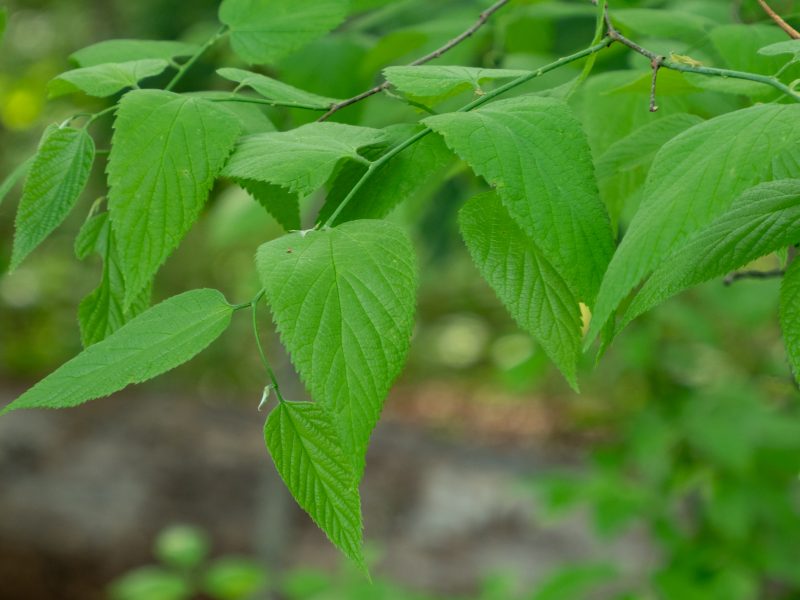
Hackberry leaves are elm-like, with unequal bases.
Just based on the leaves, hackberry is a pretty indistinctive tree. It looks vaguely elm-like. In fruit, it stands apart from elms by bearing little pea-sized drupes, very unlike the dry flat winged samaras of elms. Hackberry bark is more deeply furrowed than any other Ohio tree. Later in the season look for little pencil-eraser shaped projections on the bottoms of hackberry leaves that are galls caused by a psyllid (a type of true bug in the order hemiptera). According to the Texas A&M extension service, these litle bugs sometimes enter homes!
Basswood
(Tilia americana)
Basswood is recognized by its alternate, cordate, coarsely serrate leaves. It’s a fast growing tree with soft wood, prized for carving craft items such as duck decoys.
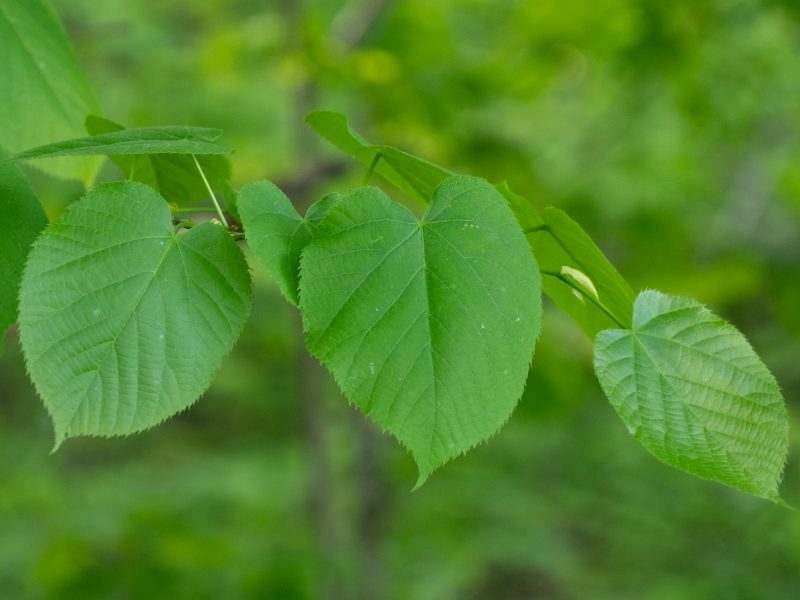
Basswood leaves are heart shaped and coarsely serrate.
Basswood flowers, blooming in late June, are an important nectar source for honeybees in early summer when spring nectar sources are finishing up. They are produced in few-flowered axillary clusters at the end of stalks fused to a strap-shaped leaf-like bract, an apparent agent of wind dispersal of the fruits (dry pea-sized drupes).
George A. Petrides, in our “textbook” Peterson Field Guides Trees and Shrubs mentions that the inner bark of basswood, especially that of the roots, is tough and fibrous, suitable for twisting into mats, cords and lines.
Sweetgum
Liquidambar styraciflua
This is what is simultaneously one of the world’s most annoying, and most wonderful, trees. Definitely not a good choice for dancing barefoot beneath, meet the sweetgum, Liquidambar styraciflua. I have one in front of my house, and since this is the tree that produces spiny balls that drop to the ground and roll onto neighboring lawns the neighbors don’t love me for having this tree, but the birds do. Goldfinches and chickadees treat the fruits (they’re actually multiples of capsules) lie little bird-feeders. Twice in late winters past there were white-winged cross-bills there!
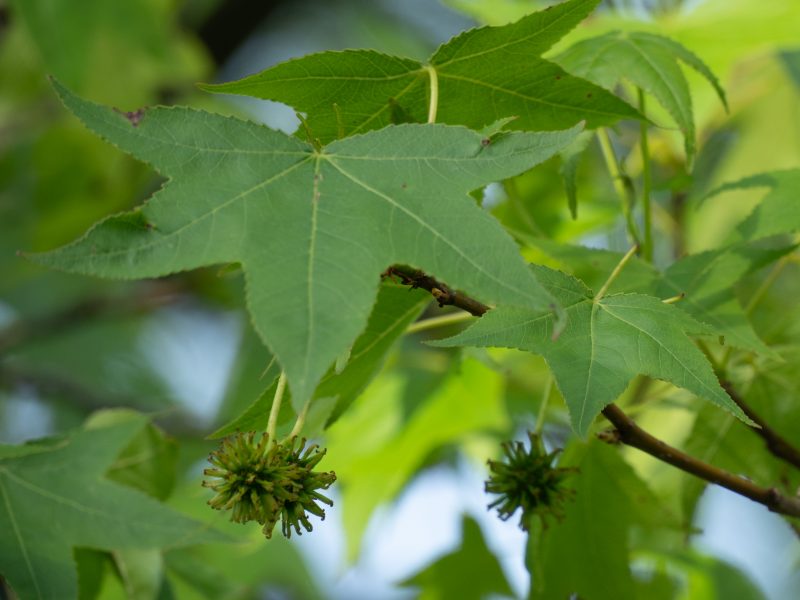
Annoying, but they are little finch feeders!
E. Lucy Braun, in The Woody Plants of Ohio (1961) explains that this is a southern tree that just barely makes it into Ohio, where it is a tree of swampy alluvial stream flats. The genus name is a combination of the Latin liquidus, liquid, and the Arabic ambar, in reference to a fragrant gum that exudes from cracks in the bark.
Blue Ash
(Fraxinus quadrangulata)
Ashes are (except for the weird boxelder maple, sometimes thus called “ash-leaved maple”) our only trees with opposite pinnately compound leaves. Blue ash, Fraxinus quadrangulata, is distinctive in two ways. its soil type, and its twigs. The species is a distinct calciphile, found in places with abundant limestone., It’s easily identified by the sharply 4-angled twigs.
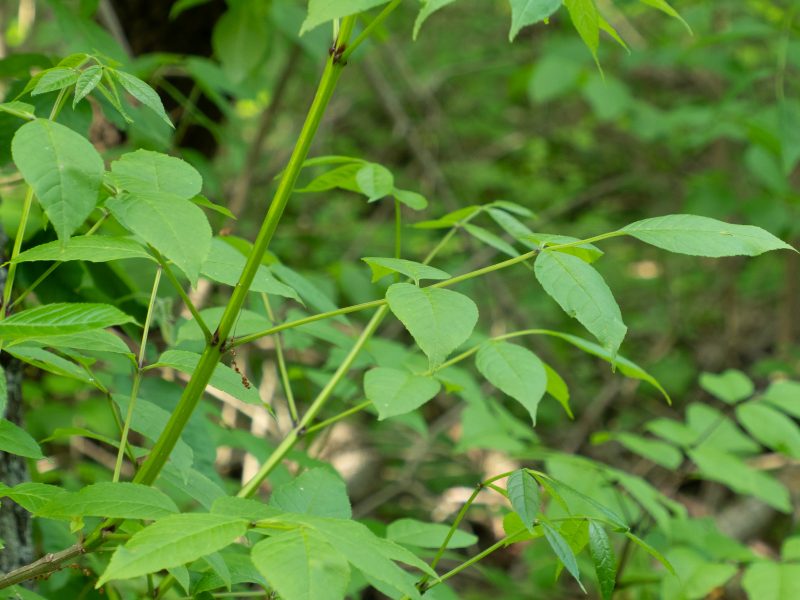
Blue has twigs are 4-angled,
Oh, and there’s something else special. The flowers, unlike all our other ashes, are “perfect,” i.e., not unisexual…bearing both stamens and a pistil. Here’s a photo I captured about a month ago showing the flowers.
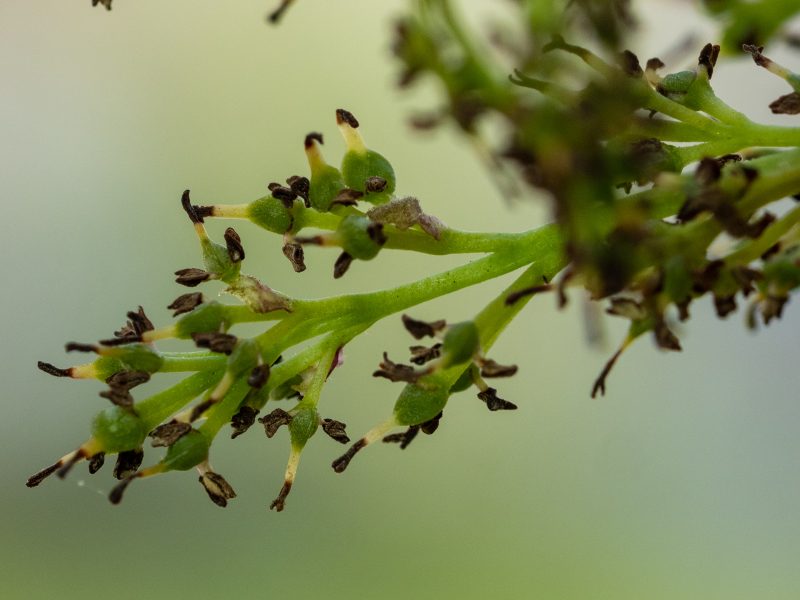
Blue ash flowers are perfect.
